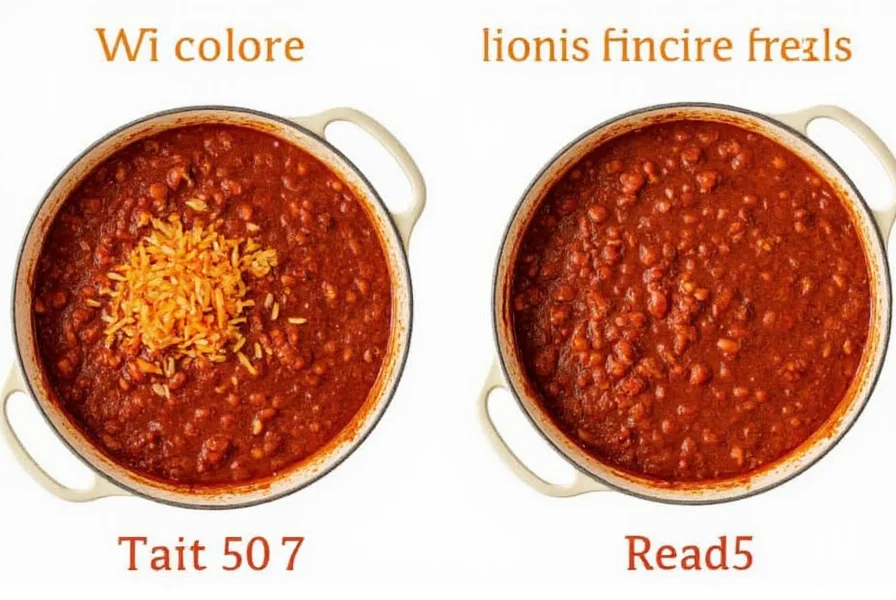Freezing chili offers a practical solution for meal prep enthusiasts and busy households. Whether you've made a large batch of homemade chili or want to preserve store-bought varieties, understanding proper freezing techniques ensures you maintain both safety and quality. This comprehensive guide covers everything you need to know about freezing chili successfully.
Why Freeze Chili?
Freezing chili provides multiple benefits for home cooks. It extends shelf life significantly beyond refrigerator storage, allowing you to enjoy homemade meals weeks or months later. Properly frozen chili maintains nutritional value while offering convenience for quick weeknight dinners. Many professional chefs actually prefer frozen chili, as the flavors often meld and improve during freezing and thawing.
Step-by-Step Guide to Freezing Chili Properly
Follow these steps for optimal results when freezing chili:
- Cool completely - Allow chili to cool to room temperature (within 2 hours of cooking) before freezing. Never put hot chili directly in the freezer.
- Portion wisely - Divide into meal-sized portions for easier thawing and reheating.
- Select appropriate containers - Use freezer-safe options with minimal air space.
- Remove air - Eliminate as much air as possible to prevent freezer burn.
- Label clearly - Include date and contents on each container.
- Freeze flat - When using bags, freeze flat for efficient storage and faster thawing.
| Container Type | Best For | Storage Duration | Tips |
|---|---|---|---|
| Freezer bags | Most chili types | 4-6 months | Remove air, lay flat to freeze |
| Glass jars | Low-acid chili | 3-4 months | Leave 1-inch headspace, use wide-mouth |
| Plastic containers | All chili types | 4-6 months | Choose BPA-free, stackable options |
| Muffin tins | Portion control | 1-2 months | Freeze portions, then transfer to bags |
How Long Does Frozen Chili Last?
When stored properly at 0°F (-18°C) or below, frozen chili maintains best quality for 4-6 months. While technically safe indefinitely when kept frozen, flavor and texture gradually decline after this period. Chili with tomato-based ingredients may experience texture changes sooner than meat-only varieties.
For meal prep purposes, consider rotating your frozen chili inventory every 3-4 months. Always check for signs of freezer burn or off odors before reheating. If you notice ice crystals throughout the container or significant discoloration, the quality has likely deteriorated.
Thawing Frozen Chili Safely
Proper thawing prevents bacterial growth and maintains quality. You have three safe options:
- Refrigerator method (best option): Transfer frozen chili to the refrigerator 24-48 hours before use. This slow thaw preserves texture best.
- Cold water method: Submerge sealed container in cold water, changing water every 30 minutes. Use immediately after thawing.
- Direct reheating: Add frozen chili directly to a saucepan with a splash of liquid, stirring frequently as it thaws and heats.
Never thaw chili at room temperature or in warm water, as this creates conditions where bacteria can multiply rapidly in the temperature danger zone (40°F-140°F).
Perfect Reheating Techniques for Frozen Chili
The reheating method significantly impacts final quality. For best results:
- Stovetop method: Place thawed chili in a saucepan over medium-low heat. Stir frequently and add small amounts of broth or water if needed to restore moisture.
- Slow cooker method: Transfer thawed chili to a slow cooker and heat on low for 2-3 hours, stirring occasionally.
- Microwave method: Use 50% power setting in 2-minute intervals, stirring between each interval. Cover to retain moisture.
Always heat chili to an internal temperature of 165°F (74°C) to ensure food safety. Consider adding fresh toppings like cilantro, cheese, or a squeeze of lime after reheating to refresh flavors.

Maintaining Flavor and Texture After Freezing
Certain ingredients respond better to freezing than others. To preserve quality:
- Add delicate ingredients like fresh herbs, dairy, or avocado after reheating
- Beans may become softer after freezing; slightly undercook them initially
- Fat separation is normal; simply stir well during reheating
- Consider adding a small amount of acid (lime juice or vinegar) after reheating to brighten flavors
Many chili enthusiasts report that freezing actually improves flavor complexity as ingredients continue to meld during storage. The key is proper technique to prevent freezer burn and moisture loss.
Common Frozen Chili Mistakes to Avoid
Avoid these frequent errors that compromise quality:
- Freezing while still hot (creates ice crystals and condensation)
- Using inappropriate containers (causes freezer burn)
- Storing for too long (beyond 6 months for best quality)
- Thawing at room temperature (food safety risk)
- Reheating at too high temperature (causes scorching)
- Freezing chili with potatoes (become grainy when frozen)
Food Safety Considerations
Follow these food safety guidelines when working with frozen chili:
- Always cool chili within 2 hours of cooking before freezing
- Maintain freezer temperature at 0°F (-18°C) or below
- Reheat to internal temperature of 165°F (74°C)
- Consume reheated chili within 3-4 days
- Never refreeze previously frozen chili that has been completely thawed
When in doubt about the safety of frozen chili, follow the guideline: "When you're uncertain, throw it out." Properly frozen chili should maintain its characteristic aroma and color. Discard if you notice sour odors, mold, or significant texture changes.
Frequently Asked Questions
How long can you keep chili in the freezer?
Properly stored frozen chili maintains best quality for 4-6 months at 0°F (-18°C) or below. While technically safe indefinitely when kept frozen, flavor and texture gradually decline after 6 months. For optimal results, consume within 4 months for tomato-based chili and 6 months for meat-only varieties.
Can you freeze chili with beans?
Yes, you can freeze chili with beans, though the texture may change slightly. Beans tend to become softer after freezing and thawing. To minimize texture changes, slightly undercook beans before freezing. When reheating, add a small amount of liquid to restore moisture. Most chili enthusiasts find the flavor improvement from freezing outweighs minor texture changes in beans.
What's the best way to reheat frozen chili?
The stovetop method provides the most control for reheating frozen chili. Place thawed chili in a saucepan over medium-low heat, stirring frequently and adding small amounts of broth if needed. For frozen (not thawed) chili, add it directly to the pan with a splash of liquid and heat slowly, stirring often. Always heat to an internal temperature of 165°F (74°C) for food safety.
Does freezing chili affect the flavor?
Freezing typically enhances chili's flavor as ingredients continue to meld during storage. Many chefs prefer frozen chili because the flavors develop more complexity. The key is proper freezing technique to prevent freezer burn, which can cause off-flavors. Adding fresh toppings like cilantro, cheese, or a squeeze of lime after reheating can refresh flavors that may have mellowed during freezing.











 浙公网安备
33010002000092号
浙公网安备
33010002000092号 浙B2-20120091-4
浙B2-20120091-4